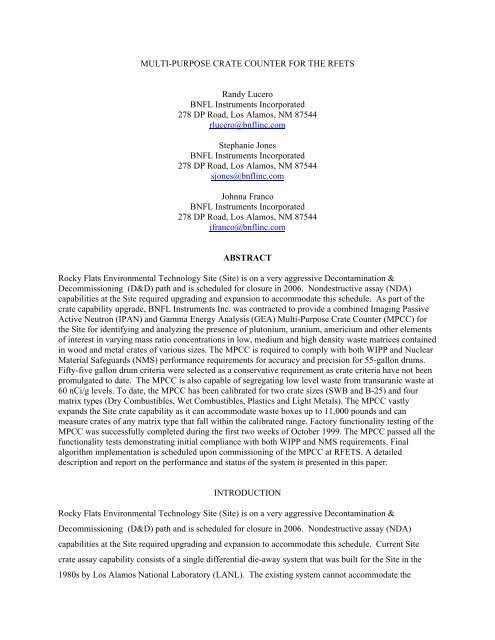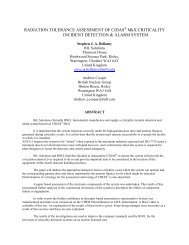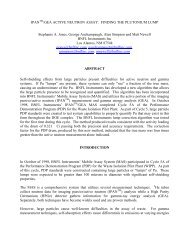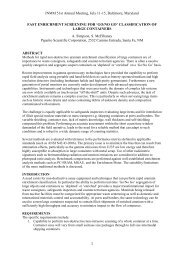Multi-Purpose Crate Counter for the RFETS - Pajarito Scientific ...
Multi-Purpose Crate Counter for the RFETS - Pajarito Scientific ...
Multi-Purpose Crate Counter for the RFETS - Pajarito Scientific ...
You also want an ePaper? Increase the reach of your titles
YUMPU automatically turns print PDFs into web optimized ePapers that Google loves.
MULTI-PURPOSE CRATE COUNTER FOR THE <strong>RFETS</strong><br />
Randy Lucero<br />
BNFL Instruments Incorporated<br />
278 DP Road, Los Alamos, NM 87544<br />
rlucero@bnflinc.com<br />
Stephanie Jones<br />
BNFL Instruments Incorporated<br />
278 DP Road, Los Alamos, NM 87544<br />
sjones@bnflinc.com<br />
Johnna Franco<br />
BNFL Instruments Incorporated<br />
278 DP Road, Los Alamos, NM 87544<br />
jfranco@bnflinc.com<br />
ABSTRACT<br />
Rocky Flats Environmental Technology Site (Site) is on a very aggressive Decontamination &<br />
Decommissioning (D&D) path and is scheduled <strong>for</strong> closure in 2006. Nondestructive assay (NDA)<br />
capabilities at <strong>the</strong> Site required upgrading and expansion to accommodate this schedule. As part of <strong>the</strong><br />
crate capability upgrade, BNFL Instruments Inc. was contracted to provide a combined Imaging Passive<br />
Active Neutron (IPAN) and Gamma Energy Analysis (GEA) <strong>Multi</strong>-<strong>Purpose</strong> <strong>Crate</strong> <strong>Counter</strong> (MPCC) <strong>for</strong><br />
<strong>the</strong> Site <strong>for</strong> identifying and analyzing <strong>the</strong> presence of plutonium, uranium, americium and o<strong>the</strong>r elements<br />
of interest in varying mass ratio concentrations in low, medium and high density waste matrices contained<br />
in wood and metal crates of various sizes. The MPCC is required to comply with both WIPP and Nuclear<br />
Material Safeguards (NMS) per<strong>for</strong>mance requirements <strong>for</strong> accuracy and precision <strong>for</strong> 55-gallon drums.<br />
Fifty-five gallon drum criteria were selected as a conservative requirement as crate criteria have not been<br />
promulgated to date. The MPCC is also capable of segregating low level waste from transuranic waste at<br />
60 nCi/g levels. To date, <strong>the</strong> MPCC has been calibrated <strong>for</strong> two crate sizes (SWB and B-25) and four<br />
matrix types (Dry Combustibles, Wet Combustibles, Plastics and Light Metals). The MPCC vastly<br />
expands <strong>the</strong> Site crate capability as it can accommodate waste boxes up to 11,000 pounds and can<br />
measure crates of any matrix type that fall within <strong>the</strong> calibrated range. Factory functionality testing of <strong>the</strong><br />
MPCC was successfully completed during <strong>the</strong> first two weeks of October 1999. The MPCC passed all <strong>the</strong><br />
functionality tests demonstrating initial compliance with both WIPP and NMS requirements. Final<br />
algorithm implementation is scheduled upon commissioning of <strong>the</strong> MPCC at <strong>RFETS</strong>. A detailed<br />
description and report on <strong>the</strong> per<strong>for</strong>mance and status of <strong>the</strong> system is presented in this paper.<br />
INTRODUCTION<br />
Rocky Flats Environmental Technology Site (Site) is on a very aggressive Decontamination &<br />
Decommissioning (D&D) path and is scheduled <strong>for</strong> closure in 2006. Nondestructive assay (NDA)<br />
capabilities at <strong>the</strong> Site required upgrading and expansion to accommodate this schedule. Current Site<br />
crate assay capability consists of a single differential die-away system that was built <strong>for</strong> <strong>the</strong> Site in <strong>the</strong><br />
1980s by Los Alamos National Laboratory (LANL). The existing system cannot accommodate <strong>the</strong>
weight loadings that Site D&D requires, nor is it suitable <strong>for</strong> Waste Isolation Pilot Plant (WIPP)<br />
certification. As part of <strong>the</strong> crate capability upgrade, BNFL Instruments Inc. was contracted to provide a<br />
combined Imaging Passive Active Neutron (IPAN) and Gamma Energy Analysis (GEA) <strong>Multi</strong>-<strong>Purpose</strong><br />
<strong>Crate</strong> <strong>Counter</strong> (MPCC) <strong>for</strong> <strong>the</strong> Site. The MPCC is a measurement instrument <strong>for</strong> identifying and<br />
analyzing <strong>the</strong> presence of plutonium, uranium, americium and o<strong>the</strong>r elements of interest in varying mass<br />
ratio concentrations in low, medium and high density waste matrices contained in wood and metal crates<br />
of various sizes. A photo of <strong>the</strong> MPCC is shown in Figure 1.<br />
Figure 1 Photo of <strong>the</strong> MPCC at <strong>the</strong> factory.
SYSTEM DESIGN<br />
System Cavity<br />
The MPCC utilizes a polyethylene shielded assay cavity that is made up of three sections: front, center,<br />
and rear. See Figure 2. The front section houses <strong>the</strong> door assembly and provides polyethylene-shielded<br />
space <strong>for</strong> <strong>the</strong> crate to be scanned. The middle section houses <strong>the</strong> neutron detectors and neutron generator.<br />
The rear section houses <strong>the</strong> gamma detectors and also provides polyethylene shielded space <strong>for</strong> <strong>the</strong> crate<br />
to be scanned. The system is designed to physically accommodate crates up to 59”W x 59”H x 91½”L. A<br />
conveyor system runs <strong>the</strong> length of <strong>the</strong> cavity allowing a linear scan of a crate.<br />
Figure 2 Top view of <strong>the</strong> MPCC<br />
Neutron Detectors<br />
The top, bottom, neutron generator and level (opposite <strong>the</strong> neutron generator) sides of <strong>the</strong> center section<br />
of <strong>the</strong> assay cavity contain cadmium shielded 3 He detector packages and polyethylene shielding. See<br />
Figure 3. The neutron generator side of <strong>the</strong> assay cavity contains <strong>the</strong> Zetatron neutron generator, housed<br />
within a moderator assembly (MA) constructed from lead, graphite and polyethylene.
The shielded detector packages comprise an outer low-energy neutron shield of cadmium. Inside <strong>the</strong><br />
cadmium are 3 He neutron detectors arranged in one row and embedded within blocks of polyethylene.<br />
These detector packages are <strong>the</strong>re<strong>for</strong>e sensitive to fast neutrons and insensitive to <strong>the</strong>rmal and low-energy<br />
neutrons. The top and bottom of <strong>the</strong> measurement cavity each contain 20 3 He detectors. The side opposite<br />
<strong>the</strong> neutron generator (level side) contains 22 3 He detectors and <strong>the</strong> side with <strong>the</strong> neutron generator<br />
contains 16 3 He detectors (MA side). This makes <strong>for</strong> a total of 78 3 He detectors.<br />
Two types of flux monitor detectors are installed in <strong>the</strong> MPCC: MA and Cavity flux monitors. The MA<br />
flux monitor comprises a bare 3 He detector, which is located inside <strong>the</strong> MA close to <strong>the</strong> neutron<br />
generator. This detector is used to monitor <strong>the</strong> magnitude of <strong>the</strong> interrogation flux produced by <strong>the</strong><br />
neutron generator during <strong>the</strong> active measurement. Two types of cavity flux monitor detectors are installed<br />
inside <strong>the</strong> assay cavity on <strong>the</strong> side opposite <strong>the</strong> neutron generator. These detectors are used to quantify <strong>the</strong><br />
absorption and moderation properties of <strong>the</strong> waste material in a crate. The two detector types are bare and<br />
shielded cavity flux monitors. A bare cavity flux monitor is a 3 He detector that is installed within a<br />
cadmium collimator arrangement, which is collimated so that <strong>the</strong>ir field of view is limited to neutrons<br />
exiting from <strong>the</strong> waste crate. A shielded cavity flux monitor is a 3 He detector that is installed within<br />
polyethylene that is completely shielded in cadmium. The two types of cavity flux monitors are<br />
configured in bare/shielded pairs at three heights on <strong>the</strong> side opposite <strong>the</strong> neutron generator making up<br />
three “dual” cavity flux monitors.
Figure 3 Cross sectional view of <strong>the</strong> mid-section of <strong>the</strong> assay cavity showing <strong>the</strong> neutron detectors,<br />
neutron generator and gamma detectors<br />
Gamma Detectors<br />
The back section of <strong>the</strong> cavity is equipped with two HPGe detectors one on each side of <strong>the</strong> cavity off set<br />
at different heights. See Figure 3. The detectors are offset to accommodate <strong>the</strong> different sizes of crates<br />
that <strong>the</strong> instrument will assay. The detectors are liquid nitrogen cooled. A filter array is built in to <strong>the</strong><br />
system using various attenuating materials such as steel and copper to reduce gamma count rates <strong>for</strong><br />
highly active crates. The operation of <strong>the</strong> HPGe detectors is fully integrated with <strong>the</strong> neutron operations<br />
of <strong>the</strong> assay system.
System Turntable<br />
A turntable assembly that receives <strong>the</strong> crate is located directly outside <strong>the</strong> door in line with <strong>the</strong> cavity. The<br />
turntable rotates <strong>the</strong> waste crate 180 degrees so that two configurations of <strong>the</strong> crate can be assayed<br />
providing <strong>for</strong> a more uni<strong>for</strong>m neutron interrogation of <strong>the</strong> crate and a symmetric neutron response. See<br />
Figure 1.<br />
PERFORMANCE REQUIREMENTS<br />
The MPCC is required to comply with both WIPP and Nuclear Material Safeguards (NMS) per<strong>for</strong>mance<br />
requirements <strong>for</strong> accuracy and precision <strong>for</strong> 55-gallon drums -- fifty-five gallon drum criteria were<br />
selected as a conservative requirement as crate criteria have not been promulgated to date -- <strong>for</strong> a range of<br />
matrices including soil, light metal waste, lead waste, dry combustibles, wet combustibles, plastic, and<br />
non-borated glass.<br />
WIPP Requirements<br />
The MPCC is required to segregate, at a minimum, low-level waste from transuranic waste at 60 nCi/g<br />
level <strong>for</strong> waste packages of each waste type of a nominal lower net weight of 300 lb.<br />
Accuracy and precision requirements are specified <strong>for</strong> various activity ranges in Table 1.<br />
Range of<br />
Waste<br />
Activity in α-<br />
Curies<br />
Nominal<br />
Compliance Point α-<br />
Curies<br />
(g WGPu)<br />
0 to 0.02 0.008<br />
(0.1)<br />
>0.02 to 0.2 0.08<br />
(1.0)<br />
>0.2 to 2.0 0.8<br />
(10)<br />
>2.0 12.8<br />
(160)<br />
Precision<br />
(%RSD)<br />
Accuracy<br />
(%R)<br />
≤ 20 70-130<br />
≤ 15 70-130<br />
≤ 10 70-130<br />
≤ 5 70-130<br />
Table 1 WIPP Quality Assurance Objectives <strong>for</strong> Radioassay 1 (<strong>for</strong> 55 gallon drums)
Nuclear Material Safeguards Requirements<br />
The MPCC is also required comply with <strong>RFETS</strong> Nuclear Material Safeguards requirements <strong>for</strong> precision<br />
and accuracy specified in Table 2.<br />
RANGE OF Pu and U (g)<br />
PRECISION (one relative<br />
standard deviation)<br />
ACCURACY (95%<br />
confidence interval<br />
<strong>for</strong> mean relative<br />
bias)<br />
≤1.0 ± 50% ± 50%<br />
>1.0 to ≤10 ± 25% ± 25%<br />
>10.0 ± 10% ±15<br />
Table 2 NMS Quality Assurance Objectives <strong>for</strong> Radioassay 2<br />
FACTORY CALIBRATION<br />
The MPCC underwent initial calibration at <strong>the</strong> factory from August to October 1999. The system was<br />
calibrated using four matrix types based on <strong>RFETS</strong> waste streams. The calibration matrix types were: Dry<br />
Combustibles, Plastics, Wet Combustibles and Light Metals. Also <strong>the</strong> system was calibrated <strong>for</strong> two box<br />
types SWB and B-25. Each matrix type was represented in each box type resulting in eight calibration<br />
points. Two of <strong>the</strong> matrix crates were provided by <strong>the</strong> Mixed waste Focus Area (MWFA) and <strong>the</strong><br />
remainder were constructed by Custom Surrogate Matrices Inc. based on <strong>the</strong> modular design used by <strong>the</strong><br />
MWFA <strong>for</strong> PDP crates. An isometric view of a standard SWB crate design is shown in Figure 4.<br />
Surrogate calibration sources were used <strong>for</strong> <strong>the</strong> calibration. Depleted Uranium was used <strong>for</strong> 235 U material<br />
and as a surrogate <strong>for</strong> 239 Pu. 252 Cf was used as a surrogate <strong>for</strong> 240 Pu.
Figure 4 Isometric view of an SWB calibration crate<br />
FACTORY TESTING<br />
The MPCC was tested at <strong>the</strong> factory <strong>for</strong> basic system per<strong>for</strong>mance evaluation. The focus of <strong>the</strong> testing<br />
was on <strong>the</strong> neutron mode of <strong>the</strong> system. The gamma detectors were calibrated and checked <strong>for</strong> good<br />
spectrum quality. The system was evaluated against <strong>the</strong> accuracy and precision requirements specified in<br />
Tables 1 and 2 and <strong>the</strong> WIPP sensitivity segregation requirement. A representative set of matrix crates<br />
from <strong>the</strong> calibration set was selected <strong>for</strong> testing over mass ranges that <strong>the</strong> surrogates represented.
System Per<strong>for</strong>mance<br />
The system sensitivity was determined <strong>for</strong> <strong>the</strong> dry combustibles matrix (as this represented <strong>the</strong> nominal<br />
case) <strong>for</strong> a uni<strong>for</strong>m distribution of radioisotopes to be approximately 7 nCi/g. This sensitivity is achieved<br />
using <strong>the</strong> active neutron mode of <strong>the</strong> system.<br />
Accuracy and precision per<strong>for</strong>mance <strong>for</strong> <strong>the</strong> neutron mode of <strong>the</strong> system was determined <strong>for</strong> sample<br />
matrix crates and mass loadings. The results are summarized in Table 3.<br />
Average<br />
Accuracy<br />
(% error)<br />
Average<br />
WIPP %RSD<br />
Average<br />
NMS %RSD<br />
Pu equivalent Mass<br />
Matrix<br />
(g)<br />
SWB DC 5.1 5.71 NA NA<br />
B25 WC 0.5 -3.38 1.41 1.40<br />
B25 PL 0.5 -23.26 2.76 1.99<br />
SWB LM 5.1 8.74 1.60 1.68<br />
B25 LM 0.5 -7.17 NA NA<br />
SWBPL 5.1 6.07 3.16 3.35<br />
Table 3 Neutron mode average accuracy and precision results from factory testing<br />
Two precision values are tabulated as WIPP and NMS use different <strong>for</strong>mulas <strong>for</strong> calculating percent<br />
Relative Standard Deviation (%RSD). For <strong>the</strong> .5g test source loadings <strong>the</strong> active mode results were used<br />
while <strong>for</strong> <strong>the</strong> 5.1 g test source loadings <strong>the</strong> passive mode results were used. Different test source positions<br />
were used among <strong>the</strong> set of test matrix crates so <strong>the</strong> results represent both matrix and positional error<br />
effects. In all cases <strong>the</strong> results exceeded <strong>the</strong> requirements.<br />
ON SITE COMMISSIONING<br />
The MPCC is scheduled <strong>for</strong> on site commissioning at <strong>RFETS</strong> from May through December of 2000. The<br />
commissioning will include final calibration using actual Pu, U and o<strong>the</strong>r representative standards. Final<br />
algorithm work will follow calibration. The commissioning will also include acceptance testing that will<br />
be used as validation to certify <strong>the</strong> system <strong>for</strong> WIPP sentencing of TRU waste. The testing will utilize<br />
PDP sources and will include QAO and o<strong>the</strong>r WAC qualification measurements.
CONCLUSION<br />
The MPCC will be vital to meeting <strong>the</strong> aggressive D&D schedule at <strong>RFETS</strong>. The MPCC vastly<br />
expands <strong>the</strong> Site crate capability as it can accommodate waste boxes up to 11,000 pounds and<br />
can measure crates of any matrix type that fall within <strong>the</strong> calibrated range. The system has<br />
demonstrated its ability to per<strong>for</strong>m as required and exceed <strong>the</strong> per<strong>for</strong>mance of previous systems.<br />
NMS acceptance and WIPP certification is <strong>the</strong> final step and ultimate goal <strong>for</strong> <strong>the</strong> system and<br />
will be achievable after commissioning.<br />
REFERENCES<br />
1."Contact-Handled Transuranic Waste Acceptance Criteria <strong>for</strong> <strong>the</strong> Waste Isolation Pilot Plant",<br />
DOE/WIPP-069 Rev 7, CAO (November 8, 1999)<br />
2. “Nuclear Material Safeguards Manual” MAN-010-NMS <strong>RFETS</strong>





